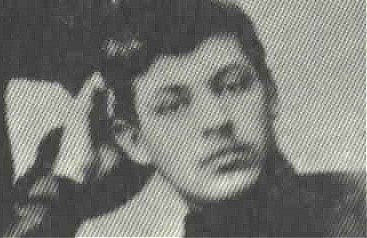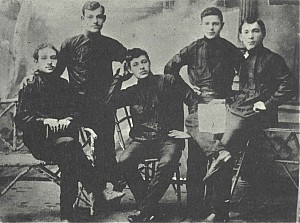
The Anarchist Encyclopedia: |

The Anarchist Encyclopedia: |

Chernoe Znamia (Black Banner)
Russian anarchist communists, advocates of terrorism & violence
(founded in Bialystock in 1903; 1906)
Chernoe Znamia
"The common object of the new anarchist organizations [circa 1905] was the total destruction of capitalism and the state, in order to clear the way for the libertarian society of the future. There was little agreement, however, as to how this was to be accomplished. The most heated disputes centered on the place of terror in the revolution.
On one side stood two similar groups, Chernoe Znamia and Beznachalie, which advocated a campaign of unmitigated terrorism against the world of the bourgeoisie.
Chernoe Znamia (The Black Banner—the anarchist emblem), easily the largest body of anarchist terrorists in the Empire, considered itself an Anarchist-Communist organization, that is, one which espoused Kropotkin’s goal of a free communal society in which each person would be rewarded according to his needs. Its immediate tactics of conspiracy and violence, however, were inspired by Bakunin.
Chernoe Znamia attracted its greatest following in the frontier provinces of the west and south. Students, artisans, and factory workers predominated, but there were also a few peasants from villages located near the larger towns, as well as a sprinkling of unemployed laborers, vagabonds, professional thieves, and self-styled Nietzschean supermen. Although many of the members were of Polish, Ukrainian, and Great Russian nationality, Jewish recruits were in the majority. A striking feature of the Chernoe Znamia organization was the extreme youth of its adherents, nineteen or twenty being the typical age. Some of the most active Chernoznamentsy were only fifteen or sixteen.
Nearly all the anarchists in Bialystok were members of Chernoe Znamia. The history of these youths was marked by reckless fanaticism and uninterrupted violence. Theirs was the first anarchist group to inaugurate a deliberate policy of terror against the established order. Gathering in their circles of ten or twelve members, they plotted vengeance upon ruler and boss. Their “Anarkhiia” (Anarchy) printing press poured forth a veritable torrent of inflammatory proclamations and manifestoes expressing a violent hatred of existing society and calling for its immediate destruction."
Text from Paul Avich, The Russian Anarchists, page 47
The organization was active in Ekaterinoslav, Odessa, Warsaw and Baku. The Revolution in the Pale reached a bloody climax in November and December 1905 with the bombing of the Hotel Bristol in Warsaw and the Cafe Libman in Odessa, which gained them much notoriety.

Photo: Chernoe Znamia meeting, Minsk, 1906; from Avrich, The Russian AnarchistsAmong the members of Chernoe Znamia were Vladimir Striga (Lapidus), Pavel Golman, Nisan Farber (legendary in the group after dying during a bomb explosion), Bidbei (Nikolai Romanov; tried in 1906 under the pseudonym Ter-Aganesov), "Tolstoy" Rostovtsev (alias of N.V. Divnogorskii), his wife Marusia Rostovtsev, Boris Speranksii, Aleksandr Kolosov (Sokolov), Vladimir Konstantinovich Ushakov ("The Admiral") & Dmitriev or Dmitrii Bogoliubov (a police spy who brought down Bidbei's circle in January 1906), Boris Engelson (a founder of the "Anarkhiia" printing press), Anton Nizhborskii, Aron Elin (alias "Gelinker"); six members were involved in the Libman bombing, five convicted (three of those executed): Moisei Mets (executed), Olga Taratuta (sentenced to 17 years, she escaped to Switzerland, but returned and was recaptured in 1908), N.M. Erdelevskii (escaped and helped found the Bundar' circle in Switzerland); others(?): Matrena Prisiazhniuk (Ukrainian individualist, sentenced to death, she committed suicide), Edgar Khorn (anarchist-communist who provided cyanide capsules to Prisiazhniuk), Ignatii Muzil (Nikolai Rogdaev's brother), Lev Aleshker (Odessa, executed).
Among their journals were "listok gruppy Beznachalie" (1905-), "Buntar'" (1906, 1908-09; The Mutineer); Chernoe Znamia (single issue, December 1905)
Repression against the anarchists was brutal. In 1907, the Tsarist Minister Stolypin set about his new "pacification" program. Anarchists tracked down & were tried by court martial in which preliminary investigation was waived, verdicts delivered within two days and sentences executed immediately. Rather than succumb to the ignominy of arrest, many anarchists preferred suicide when cornered. Those that were caught would usually deliver a rousing speech on Justice and Anarchy before they were executed, in the manner of Ravachol and Emile Henry. By 1909 most of the anarchists were either dead, exiled or in jail. Anarchism was not to effectively resurface in Russia until 1917.
page created July 2007
Use your back button to return to your previous page,
The Anarchist Encyclopedia | Daily Bleed Calendar | The Stan Iverson Archives | The Anarchist Timeline
anti-CopyRite 1997-3000, more or less
Questions, suggestions, additions, corrections to David Brown at recall@recollectionbooks.com
The Anarchist Encyclopedia is freely sponsored & produced by Recollection Used Books